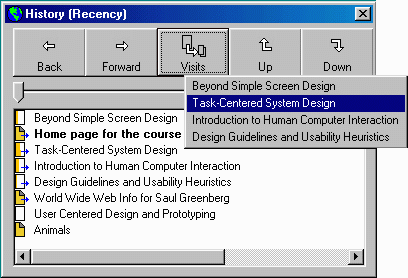WWW Page Revisitation
alternate strategies

A person's ability to find and navigate effectively to new information and to new web sites is extremely important, and this has driven many researchers to understand both how people navigate within the Web, and how Web sites and browsers should be designed. Equally important, however, is a person's ability to return to pages and sites he or she has already seen: page revisitation is a regular and surprisingly strong navigational occurrence. In our previous work, for example, we found that around 60% of all pages an individual visits are to pages they have visited previously. Given this statistic, we believe that Web browsers should go to great lengths to support effective page revisitation. While most browsers do provide revisitation support through various mechanisms, we want to make sure that these mechanisms are effective. In particular, we are investigating alternate behaviours of the back button found in most browsers, as well as the problems and prospects of graphical history lists.
We are prototyping and testing a system that adds new kinds of back/forward and up/down buttons along with an integrated history list and bookmarking system. The system in the figure works with Microsoft's Internet Explorer. The system optionally displays a recency-ordered history list without duplicates (as shown), allowing a person to select an item directly from the list. The icons on the left indicate whether or not the person followed any links from a particular page (arrows vs. no arrows) and how often a person has returned to that page (icons for frequently visited pages gradually fill with yellow). People can mark important pages by clicking the icon, which changes it into a 'dogear'. Moving the slider progressively hides infrequently visited pages; when moved all the way to the right, only dogears are shown. The back and forward buttons implement "recency with temporal ordering", a particular way to go through previously visited pages. Unlike the typical stack-based back button that loses pages, people can always return to a previously seen page. As well, the history lists reflects one's actions with back by bolding the current item (e.g., the user has gone back to the now-bolded second item on the list "Home page for..."). The up and down buttons implement the old stack-based behaviours, with the name change reflecting the fact that the stack moves people up and down the navigational hierarchy. Finally, the visits button displays a localized history list as a menu. That is, the menu displays in time order all the pages that have been accessed from the current.
We have analyzed various revisitation methods. We also have other prototypes as well, one showing a sophisticated "site map" of pages a person has visited.
Primary Investigators
Saul Greenberg, University of Calgary, Canada
Andy Cockburn, University of Canterbury, New Zealand
Shaun Kaasten (as part of his Honors Thesis), University of Calgary, Canada
Milestones
- First paper describing alternate behaviours of the
backbutton produced in March 1999. - Various working prototypes have been developed.
Current Status
- This is an active project.


 ucalgary.ca
ucalgary.ca